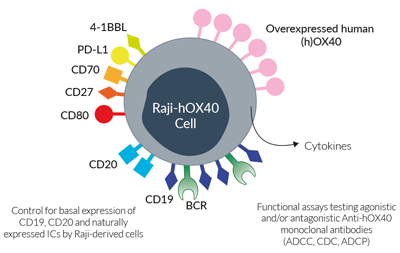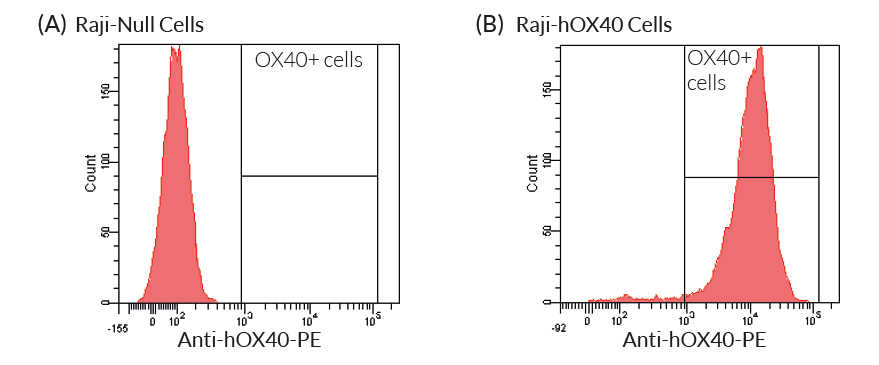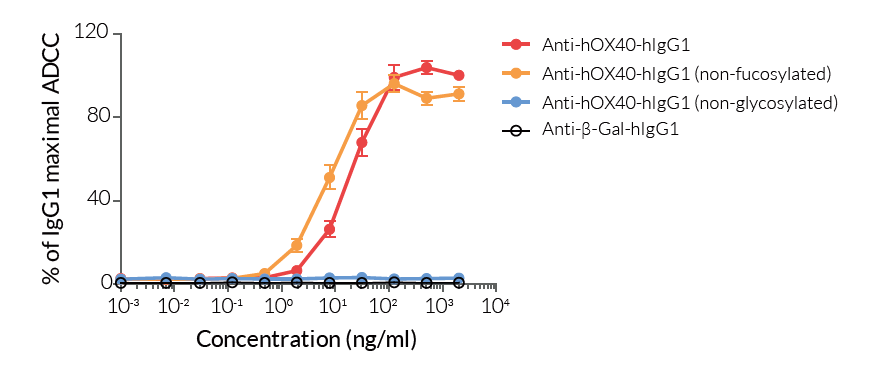Human OX40-expressing Raji Cells
| Product | Unit size | Cat. code | Docs. | Qty. | Price | |
|---|---|---|---|---|---|---|
|
Raji-hOX40 Cells Human lymphoblast cells - ADCC OX40 Target Cells |
Show product |
3-7 x 10e6 cells |
raji-hox40
|
|
||
|
Raji-hOX40 vial Additional cell vial |
Show product |
3-7 x 10e6 cells |
raji-hox40-av
|
Notification:
Reference #raji-hox40-av can only be ordered together with reference #raji-hox40.
Human OX40-expressing B cells
Raji-hOX40 cells were developed from the human Raji cell line, a human B lymphocyte-derived cell line, and engineered to stably overexpress the human OX40 gene. Raji cells have been successfully used as target cells in human effector studies such as antibody-dependent cellular cytotoxicity (ADCC), either with peripheral blood mononuclear cells, natural killer (NK) cells, or T cell-derived Jurkat reporter cells.
OX40 (also known as CD134, TNFRSF4) is a co-stimulatory immune checkpoint (IC) and a member of the tumor necrosis factor receptor superfamily (TNFRSF). OX40 is transiently expressed on activated CD4+ and CD8+ T-cells, while its ligand, OX40 ligand (OX40L, TNFSF4, CD252), is predominantly expressed on activated antigen-presenting cells [1]. The engagement of OX40 with OX40L ultimately leads to the activation of the NF-κB pathway [1,2]. The OX40-OX40L axis promotes the survival of effector T cells and the generation of T cell memory, while also being associated with local inflammation and auto-immune disease (e.g. SLE) [1]. Specifically for inflammatory diseases, novel therapeutics that aim to antagonize this interaction are of interest in the clinic [3]. On the other hand, treatment with agonistic anti-OX40 mAbs has been shown to augment T cell differentiation and cytolytic function leading to enhanced anti-tumor immunity in a variety of tumor models [2]. Thus, combination therapies with blockade IC mAbs (i.e. anti-CTLA-4 and anti-PD-1) are being explored [2,4].
Features of Raji-hOX40 cells:

Surface expressed markers and ICs in Raji-hOX40 cells
- Stable overexpression of the human OX40 gene
- Characterized by a number of cell-surface expressed markers including the B cell receptor (BCR), CD19, and CD20
- Constitutive expression of various immune checkpoints (ICs) such as CD27, CD70, CD80, PD-L1, and 4-1BBL
Applications for Raji-hOX40 cells:
- Target cell line for ADCC assays using InvivoGen's Jurkat-Lucia™ NFAT-CD16 cells
- Target cell line for cell toxicity assays using NK or CAR-T cells
- For use in the development of novel OX40 agonistic and antagonistic mAbs
Validation of Raji-hOX40 cells:
- Overexpression of OX40 verified by flow cytometry
- Functionally tested as target cells in ADCC assays using anti-human OX40 mAbs and Jurkat-Lucia™ NFAT-CD16 cells
- Guaranteed mycoplasma-free
References:
1. Gough, M.J. et al. 2009. OX40 (CD134) and OX40L. Adv Exp Med Biol 647, 94-107.
2. Alves Costa Silva, C. et al. 2020. New pathways in immune stimulation: targeting OX40. ESMO Open, 5.
3. Webb, G.J. et al. 2016. OX40, OX40L and Autoimmunity: a Comprehensive Review. Clin Rev Allergy Immunol 50, 312-332.
4. Linch, S.N. et al. 2015. OX40 Agonists and Combination Immunotherapy: Putting the Pedal to the Metal. Front Oncol 5, 34.
Specifications
Antibiotic resistance: Blasticidin
Growth medium: IMDM, 2 mM L-glutamine, 25 mM HEPES, 10% heat-inactivated fetal bovine serum (FBS; 30 min at 56 °C), Pen-Strep (100 U/ml-100 µg/ml), 100 µg/ml Normocin™
Test medium: IMDM, 2 mM L-glutamine, 25 mM HEPES, 10% heat-inactivated FBS, Pen-Strep (100 U/ml-100 µg/ml)
Quality control:
- Human OX40 expression has been verified by flow cytometry.
- Induction of antibody-dependent cellular cytotoxicity (ADCC) has been validated using anti-hOX40 antibodies and InvivoGen's Jurkat-NFAT Lucia™ CD16 reporter cell line.
- The stability for 20 passages following thawing has been verified.
- Raji-hOX40 cells are guaranteed mycoplasma-free.
Contents
- 3-7 x 106 Raji-hOX40 cells in a cryovial or shipping flask.
- 1 ml of Blasticidin (10 mg/ml). Store at 4 °C or at -20 °C.
- 1 ml of Normocin™ (50 mg/ml). Normocin™ is a formulation of three antibiotics active against mycoplasmas, bacteria, and fungi. Store at -20 °C.
IMPORTANT: If cells are shipped frozen (i.e. in a cryovial) and are not frozen upon arrival, contact InvivoGen immediately.
![]() Shipped on dry ice (Europe, USA & Canada)
Shipped on dry ice (Europe, USA & Canada)








